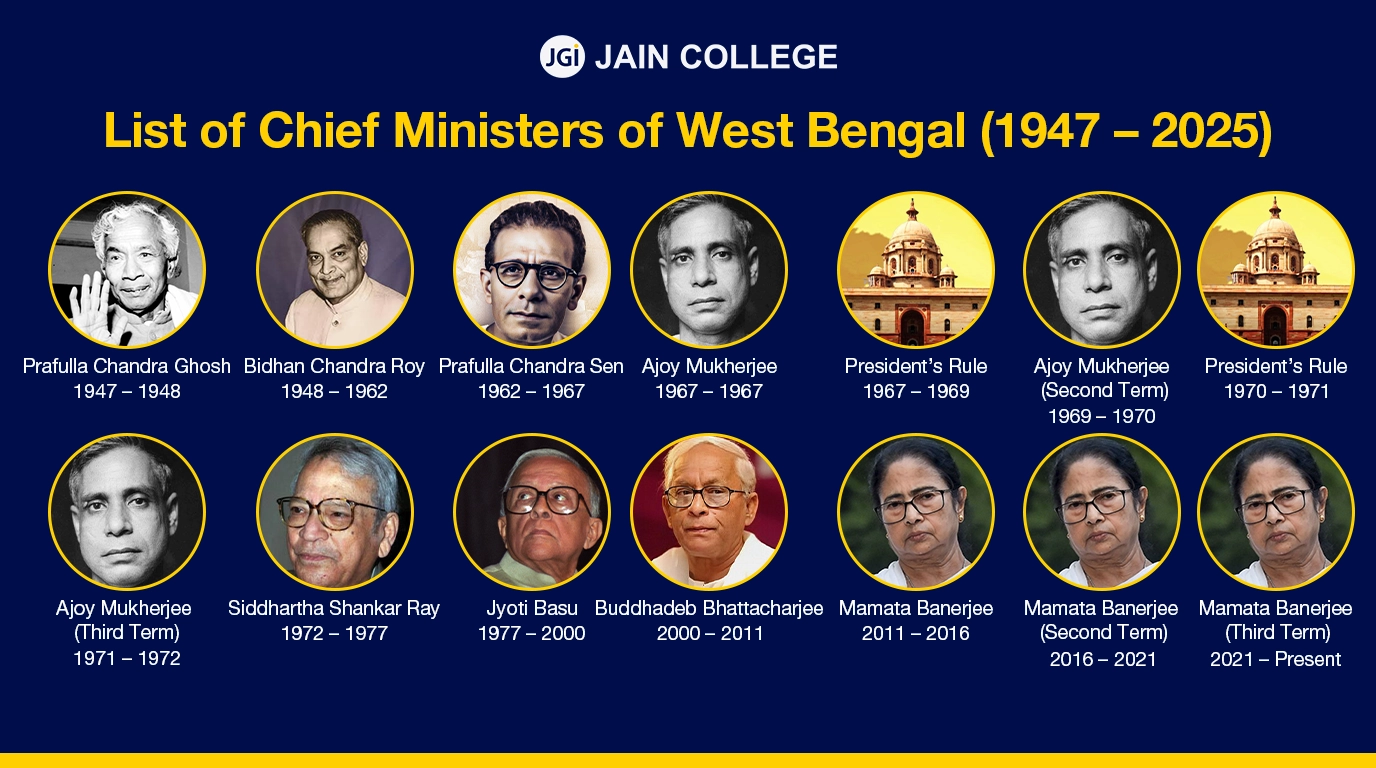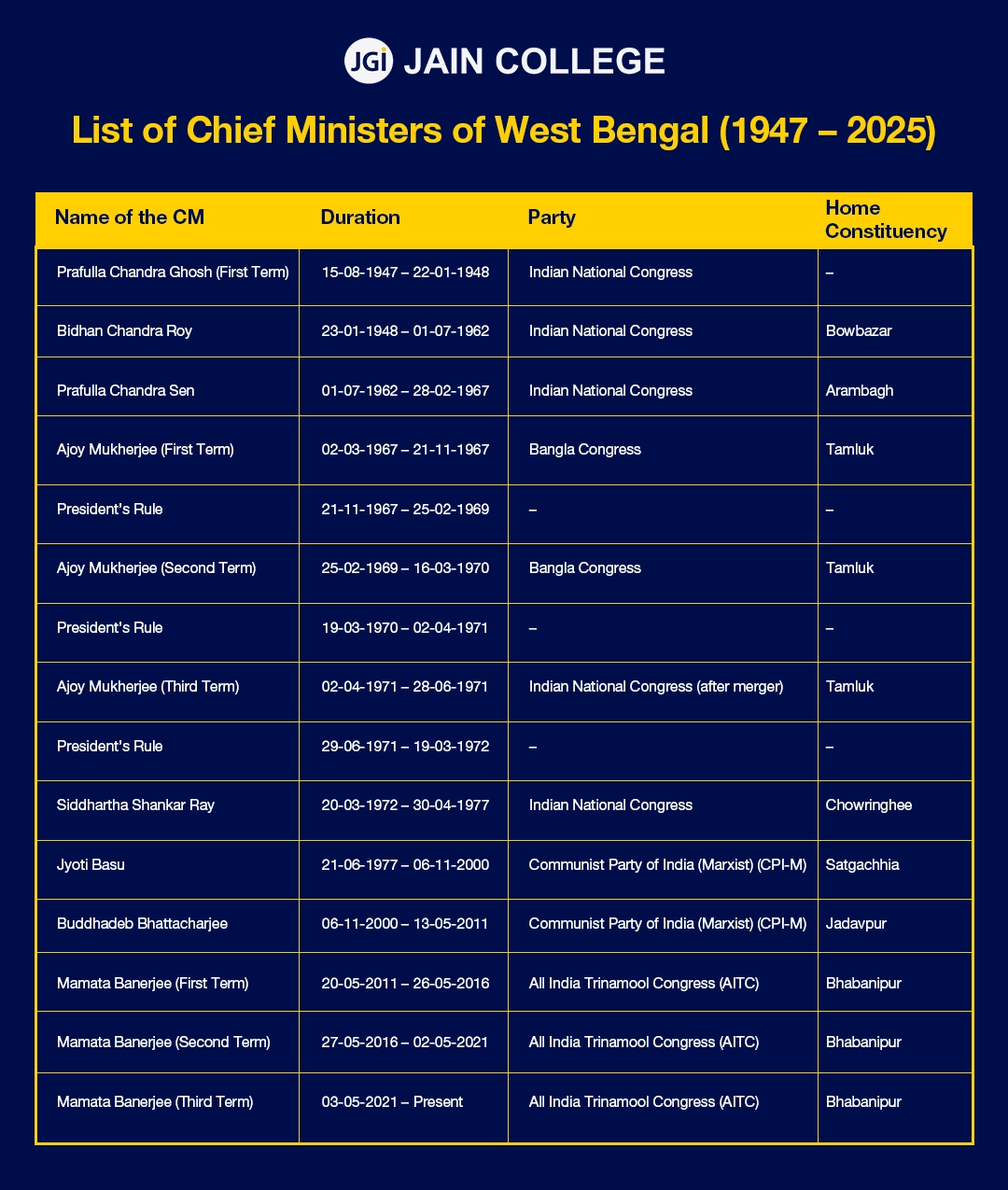
| Name of the CM | Duration | Party | Home Constituency |
| Prafulla Chandra Ghosh (First Term) | 15-08-1947 – 22-01-1948 | Indian National Congress | – |
| Bidhan Chandra Roy | 23-01-1948 – 01-07-1962 | Indian National Congress | Bowbazar |
| Prafulla Chandra Sen | 01-07-1962 – 28-02-1967 | Indian National Congress | Arambagh |
| Ajoy Mukherjee (First Term) | 02-03-1967 – 21-11-1967 | Bangla Congress | Tamluk |
| President’s Rule | 21-11-1967 – 25-02-1969 | – | – |
| Ajoy Mukherjee (Second Term) | 25-02-1969 – 16-03-1970 | Bangla Congress | Tamluk |
| President’s Rule | 19-03-1970 – 02-04-1971 | – | – |
| Ajoy Mukherjee (Third Term) | 02-04-1971 – 28-06-1971 | Indian National Congress (after merger) | Tamluk |
| President’s Rule | 29-06-1971 – 19-03-1972 | – | – |
| Siddhartha Shankar Ray | 20-03-1972 – 30-04-1977 | Indian National Congress | Chowringhee |
| Jyoti Basu | 21-06-1977 – 06-11-2000 | Communist Party of India (Marxist) (CPI-M) | Satgachhia |
| Buddhadeb Bhattacharjee | 06-11-2000 – 13-05-2011 | Communist Party of India (Marxist) (CPI-M) | Jadavpur |
| Mamata Banerjee (First Term) | 20-05-2011 – 26-05-2016 | All India Trinamool Congress (AITC) | Bhabanipur |
| Mamata Banerjee (Second Term) | 27-05-2016 – 02-05-2021 | All India Trinamool Congress (AITC) | Bhabanipur |
| Mamata Banerjee (Third Term) | 03-05-2021 – Present | All India Trinamool Congress (AITC) | Bhabanipur |

The first CM of West Bengal after Independence, Ghosh represented the Congress. His short tenure was transitional, dealing with the effects of Partition and refugee influx from East Pakistan (now Bangladesh).
One of Bengal’s most respected leaders, Dr. B. C. Roy was a physician and visionary. He is credited with modernizing Kolkata, establishing institutions like IIT Kharagpur, and driving industrial growth. His era is often remembered as Bengal’s golden age of governance.
A Gandhian and close aide of B. C. Roy, Sen emphasized rural development, agriculture, and cooperative movements. His government, however, faced growing unrest and food shortages.
Ajoy Mukherjee, leader of the Bangla Congress, became CM three times, often in coalition governments. His terms saw political instability and increasing influence of leftist forces.
Congress leader Siddhartha Ray’s tenure coincided with the Emergency era (1975–77). His government focused on law and order, infrastructure, and urban development, but also faced criticism for its handling of civil liberties.
The longest-serving Chief Minister in India’s history (23 years), Jyoti Basu was the face of the Left Front. His government implemented Operation Barga (land reforms), strengthened panchayati raj (local governance), and ruled Bengal with stability. Despite criticisms of industrial stagnation, he remains a towering figure in Indian politics.
Buddhadeb tried to modernize West Bengal’s economy by inviting industries and IT investments. However, his government faced backlash over land acquisition issues in Singur and Nandigram, which weakened Left dominance and paved the way for Mamata Banerjee’s rise.
Founder of the Trinamool Congress (TMC), Mamata ended 34 years of Left Front rule in 2011. Known as “Didi”, her governance focuses on welfare schemes like Kanyashree, Sabuj Sathi, and Swasthya Sathi. She has maintained a strong base among women and rural voters. Re-elected in 2016 and 2021, she continues as CM in 2025, making her one of India’s most influential regional leaders.

JAIN PU College, a part of the renowned JGI Group, is committed to empowering students with quality education.
Beyond academics, the college ensures its online content reflects the same standard of excellence. Every blog and article is meticulously vetted and proofread by subject matter experts to ensure accuracy, relevance, and clarity. From insightful educational topics to engaging discussions, JAIN PU College's content is crafted to inform, inspire, and add value to its readers, reflecting the institution's commitment to intellectual growth and innovation.
View all Blogs